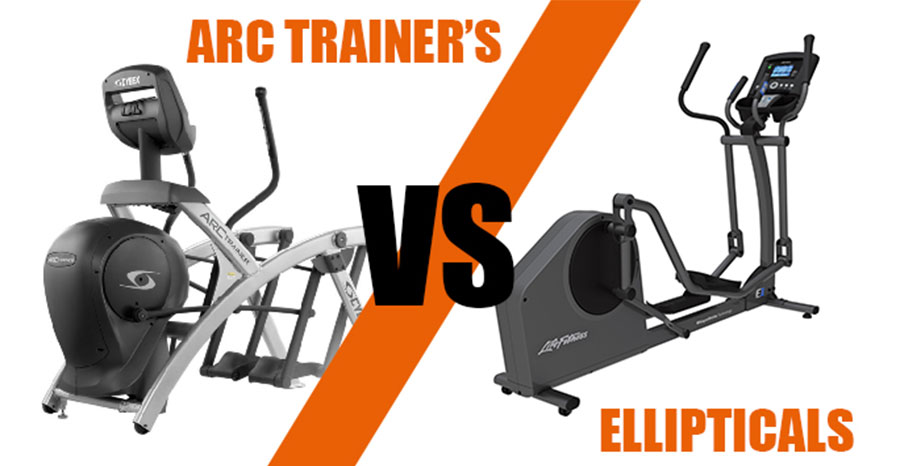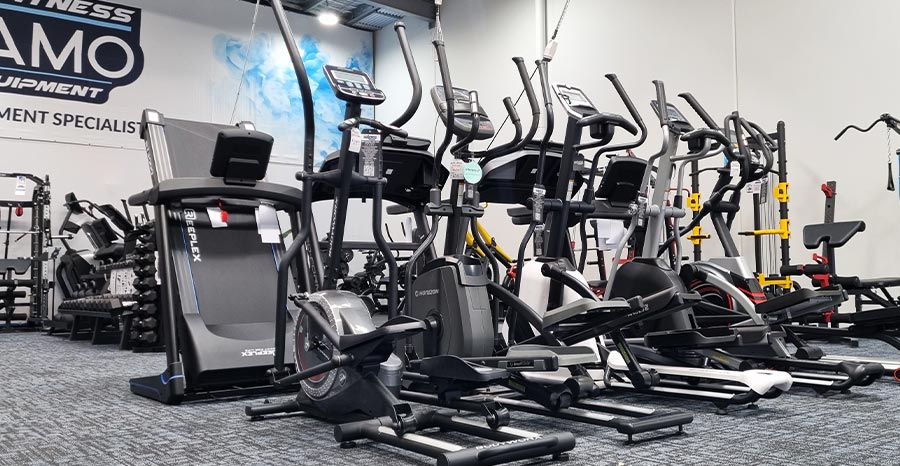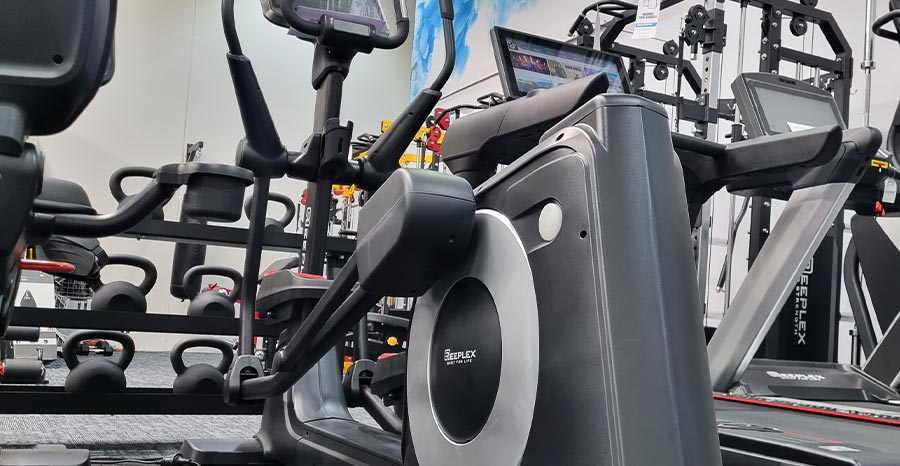
What is the difference between a Cross trainer and an Elliptical trainer?
History
Cross trainers and elliptical trainers were first developed by Precor. They developed them for their low-impact design, which limits tendon and joint stress, which in turn reduces the chance of injury. They were also created for their use in rehabilitation, as they are recommended by physiotherapists and doctors for those with past injuries or joint pains.
What is a Cross Trainer?
A cross trainer, also known as an elliptical machine, is a stationary exercise machine that simulates non-impact walking or running. It’s designed to allow your feet to move in an elongated circular motion without causing the high impact of traditional jogging, thus minimizing the stress on your joints. Typically, a cross trainer incorporates handles that move in sync with the pedals, offering a full upper and lower body workout. This dual-action, combining arm and leg exercise, makes it an effective tool for enhancing cardiovascular fitness and muscle tone.
Types of Cross Trainers
Cross trainers vary mainly in terms of their drive system and design features:
- Manual or Magnetic Cross Trainers: These are basic models where you can adjust the resistance manually using a tension knob. Magnetic cross trainers offer smoother resistance adjustments.
- Front-Driven Cross Trainers: These models have the flywheel located at the front and often feature a longer stride, making the motion more akin to climbing stairs.
- Rear-Driven Cross Trainers: More common and traditional, these have the flywheel at the back, providing a motion closer to natural walking or running.
- Foldable Cross Trainers: Ideal for home use where space is a concern, these models can be folded up and stored away after workouts.
- 2-in-1 Cross Trainers: These versatile machines can function as both a cross trainer and an exercise bike, often featuring an adjustable saddle.
Benefits of Cross Trainers
Cross trainers offer a range of health and fitness benefits, making them a popular choice for home gym setup and fitness centers alike:
- Low-Impact Exercise: They provide a significant reduction in impact compared to running, thus lowering the risk of joint injuries.
- Whole-Body Workout: By engaging both the upper and lower body, cross trainers offer a comprehensive workout that can improve overall muscle tone and cardiovascular health.
- Calorie Burning: Effective for weight loss, these machines can help burn calories efficiently, particularly when resistance and intensity are increased.
- Improved Cardiovascular Health: Regular use improves heart and lung health, boosting overall aerobic fitness.
- Versatility: With adjustable resistance and the ability to pedal forwards or backwards, cross trainers allow for varied and challenging workouts.
Cross trainers are an excellent choice for people seeking a versatile, low-impact way to improve fitness levels, tone muscles, and manage weight effectively. Whether for rehabilitation, fitness maintenance, or intense training, they offer a convenient and effective workout option suitable for all ages and fitness levels.
Disadvantages of Cross Trainers
While cross trainers are popular for their numerous health benefits, there are some disadvantages to consider as well. One significant drawback is their limited capacity for high-impact workouts, which are essential for building bone density. This makes cross trainers less ideal for those looking to improve bone health through exercise. Additionally, the repetitive nature of the workouts can become monotonous over time, potentially leading to decreased motivation for some users. Another practical concern is the size and cost of these machines; they can be quite large and expensive, posing a challenge for those with limited space or budget constraints.
Cross Trainer Workouts
Cross trainer workouts are diverse and can be tailored to meet various fitness goals. For those looking to enhance cardiovascular fitness, interval training on a cross trainer is highly effective. This involves alternating between high and low intensity periods, which helps to burn more calories and improve heart health. For muscle strengthening, particularly in the lower body, increasing the resistance of the machine can provide a more challenging workout. Additionally, the handles of the cross trainer allow for upper body exercises, making it possible to achieve a full-body workout that targets multiple muscle groups simultaneously.
Why You Should Have a Cross Trainer
Having a cross trainer for sale at home offers several advantages. Firstly, it provides the convenience of being able to exercise indoors, regardless of weather conditions. This makes it easier to maintain a consistent workout routine. The versatility of a cross trainer is another significant benefit, as it supports a wide range of exercises from light cardio to intense strength training sessions. This makes it suitable for individuals at different fitness levels and with various health and fitness goals. Moreover, for those recovering from injuries or with chronic joint issues, the low-impact nature of cross trainer workouts makes it a safer option that minimizes the risk of further injury while still allowing for an effective workout.
What is an Elliptical Trainer?
A ProForm elliptical trainer, also known as a cross-trainer, is a stationary exercise machine that simulates walking, running, or stair climbing without causing excessive pressure on the joints. This low-impact nature reduces the risk of impact injuries, making it suitable for individuals with certain injuries who still wish to exercise. Introduced in the 1990s by Precor, the elliptical trainer incorporates both lower and, in many models, upper body exercise through a smooth, elliptical motion. This type of exercise is weight-bearing, which is beneficial for bone health, yet it minimizes the stress on joints compared to other high-impact exercises like running.
Types of Elliptical Trainers
Elliptical trainers can be categorized based on the location of the motor or “drive,” which affects their operation and feel:
- Rear Drive Ellipticals: The oldest design, where the drive mechanism is located at the back of the machine. This type is often favored for its smooth operation and natural stride.
- Front Drive Ellipticals: These have the drive system located at the front and tend to be more compact. They might feel slightly more choppy compared to rear-drive models.
- Center Drive Ellipticals: A newer category, with the drive located at the center, these models often provide a more upright position and can offer a more comfortable and natural exercise posture.
Some models feature adjustable incline and stride length, which can target different muscle groups and increase the intensity of the workout.
Benefits of Elliptical Trainers
Elliptical trainers offer several health and fitness benefits:
- Full-body Workout: Most ellipticals work both the upper and lower body, although the intensity can vary based on the model.
- Low Impact Exercise: Ideal for people with joint issues or those recovering from injury, as the elliptical motion reduces the impact on the knees, hips, and back.
- Calorie Burning: Effective for burning calories, which can aid in weight loss. The amount burned varies based on the intensity of the workout and the user’s body weight.
- Cardiovascular Health: Regular use improves cardiovascular endurance and health.
- Strength Building: Resistance settings allow for muscle strengthening and toning, particularly of the legs, glutes, and in many cases, the upper body.
- Versatility: Suitable for all fitness levels, from beginner to advanced, and can be used for everything from light exercise to intense interval training.
Elliptical trainers are an excellent choice for home gyms as they provide a diverse range of exercise options in a single machine, accommodating different fitness levels and goals. They are particularly appealing for those seeking effective, low-impact workouts that offer variety and promote overall fitness and well-being.
Disadvantages of Elliptical Trainer
While elliptical trainers offer numerous benefits, there are several drawbacks that might affect their suitability for some individuals or situations. One of the primary concerns is that elliptical trainers provide a less dynamic range of motion compared to real-life walking or running. This means that while they are excellent for cardiovascular workouts and muscle toning, they do not perfectly mimic natural body movements, which can be a disadvantage for athletes or individuals looking to improve their performance in specific sports or activities.
Additionally, because the movement on an elliptical is guided by the machine, there’s a lower requirement for balance and stabilization compared to traditional ground-based exercises. This means that while ellipticals are excellent for those with balance issues or injuries, they are less effective at training the smaller stabilizing muscles that are crucial for joint health and overall mobility.
Moreover, the repetitive motion on an elliptical can sometimes lead to numbness in the feet, a phenomenon known as “elliptical foot.” This occurs because the foot remains in constant contact with the pedal, limiting circulation and causing discomfort for some users. The risk of this can be minimized by regularly repositioning the feet during the workout.
Finally, elliptical trainers can be relatively expensive and require a significant amount of space, making them less accessible for individuals with limited home space or budget constraints.
Elliptical Trainer Workouts
Elliptical trainer workouts can vary greatly in terms of intensity and focus, making them adaptable to a wide range of fitness goals. A standard workout on an elliptical typically involves setting a comfortable resistance level and pedaling at a steady pace, which is excellent for aerobic conditioning and weight loss. For those looking to increase the challenge, many ellipticals offer adjustable settings that can simulate uphill climbing, which increases the intensity of the workout and targets the leg muscles more aggressively.
High-Intensity Interval Training (HIIT) can also be effectively performed on an elliptical trainer. By alternating between high-speed, high-resistance bursts and slower, recovery phases, users can maximize calorie burn and improve aerobic capacity in a shorter period. This type of training is beneficial for those with limited time who want an effective, efficient workout.
For individuals focused on muscle toning or bodybuilding, ellipticals with dual-action arms allow for a simultaneous upper-body workout as you pedal. This can help to tone arms, shoulders, and back while also increasing the overall calorie expenditure of the workout.
Why You Should Have an Elliptical Trainer?
Owning an elliptical trainer can be a smart investment for several reasons. First and foremost, it provides a convenient and effective way to improve cardiovascular health, enhance physical fitness, and manage or reduce weight, all from the comfort of one’s home. The low-impact nature of the elliptical makes it an excellent choice for those who are concerned about joint health, particularly individuals who are older, overweight, or recovering from injuries.
Additionally, the versatility of the elliptical trainer makes it suitable for users of all fitness levels—from beginners to athletes—allowing for a range of workouts that can be customized to meet individual health and fitness goals. It can be used for gentle rehabilitation exercises, moderate cardio workouts, or intense interval training, providing value across a broad spectrum of use cases.
Moreover, having an elliptical trainer at home encourages regular physical activity, which is crucial for maintaining health and wellness. It eliminates common barriers to exercise such as bad weather, gym fees, or lack of time, making it easier to integrate consistent physical activity into a daily routine.
The Main Differences Between Elliptical Trainers and Cross Trainers
The terms “elliptical trainer” and “cross trainer” are often used interchangeably, but there are subtle differences between the two, primarily based on their design and the type of workout they provide.
An elliptical trainer is primarily focused on the lower body. It features pedals that move in an elliptical motion and often have stationary handlebars, which helps to minimize the stress on the joints while still providing a solid cardiovascular workout. This design makes it particularly suitable for those looking to focus on their lower body or for individuals who require a low-impact exercise option due to joint issues.
On the other hand, a cross trainer is designed to offer a full-body workout. It includes moving handlebars that work in conjunction with the pedals, allowing the user to engage not just the lower body but also the upper body muscles, including the arms, chest, and back. This dual-action is more demanding and can lead to a higher calorie burn and increased muscle tone across more muscle groups.
The choice between these two machines largely depends on your personal fitness goals and any physical limitations you might have. If you’re looking for a comprehensive workout that involves both the upper and lower body, a cross-trainer would be ideal. However, if your focus is more on leg strength and cardiovascular fitness, particularly if you have joint concerns, an elliptical trainer might be the better choice.
In summary, while both machines provide excellent cardiovascular workouts and are low impact, the key difference lies in the additional upper body workout provided by the cross trainer’s moving handlebars compared to the more lower body-centric workout of an elliptical trainer.
Both types of elliptical machines are the same in terms of their feel, and it all depends on the type of cross trainer that is suitable for you. There is no right or wrong here. It’s just a matter of personal preference.
So, in studying the main difference between cross trainers and elliptical trainers, the fact is that an elliptical trainer uses a static handle, which requires the person exercising with this type of machine to primarily use their legs. In other words, you cannot use your hands other than just holding on to the handle.
The cross trainer, on the other hand, has the option of using only your legs to operate the machine and/or using both your legs and arms to operate. Most cross trainers have both handles that move back and forth as you move your legs while using the machine as well as a static handle if the person chooses to focus more on the legs, which means they are two in one.

One last important point
Many manufacturers choose to call their machines cross trainers while others tend to use the word elliptical trainer, even though they are, in fact, cross trainers.
So, in conclusion, based on what units are out there on the market and given the fact, manufacturers often do not stick to using accurate terminology. We can say that both an elliptical trainer and cross trainer are 99% of the time the exact same thing, just with different names.

Do you have Any More Questions About The Difference Between Cross Trainers & Ellipticals?
The best thing to do is to ask, check the specifications, or just look at the pictures. Also, please feel free to check out our range of cross-trainers here at Dynamo Fitness Gym Equipment. With 3 stores in Perth, Melbourne, and Sydney, we have a store near you and friendly staff on hand to help you with any questions. Shop pilates reformer, adjustable dumbbells, ProForm treadmills, reformer machines, and weight racks for commercial fitness at Dynamo Malaga gym store and gym equipment Melbourne store.
Thank you for reading…




